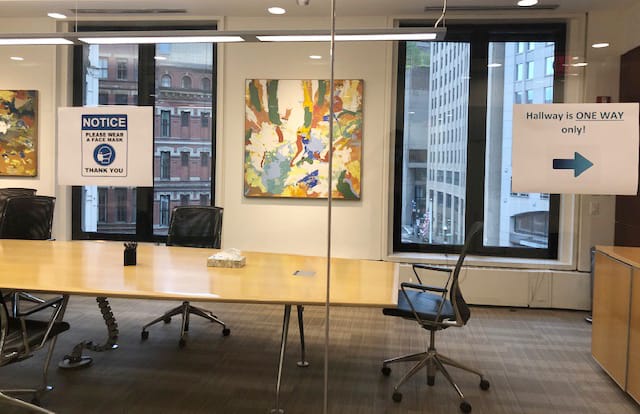
Companies prepare offices to reopen.
Source: Karen Firestone
When governors, mayors, and national leaders told us to stay home and work remotely, back in what seems like the Ice Age, we were thrust into a state of shock, disorientation, and, ultimately, acceptance.
Two and half months later, we have grown accustomed to Zoom, Covid-19 news updates, our colleagues’ disheveled hair, and wearing masks. However, CEO’s, including me, are now planning how to physically reopen our enterprises over the next few weeks and months.
I sent a survey to hundreds of top executives, receiving 130 completed questionnaires, asking about their current business conditions, their expectations over the next six months, and their concerns. My hope was to offer observations and implications that emerged from the data to the CEO community as a gauge of what its members are thinking and to policymakers building a roadmap for the future.
Because the surveyed group included many graduates of MBA programs whose population gravitates toward financial services and consulting, 37% of the respondents work in those industries. Over half, or 57%, work in companies with fewer than fifty employees and only 20% are part of a large firm with over a thousand people. Both the enterprise size and its industry sector seemed to strongly influence the answers.
Given that the coronavirus has had a disastrous impact on global gross domestic product, I was amazed that sales were flat to slightly higher for 50% of the participants. That makes sense, when considering that 74% of those from finance and consulting, reported flat to slightly higher sales.
These business models include ongoing fees based on assets under management, long term projects still in progress, and assignments related to management strategy in the new Covid-19 world. On the other side of the spectrum were 11% of those surveyed whose sales have dropped over 50%. Those hit the hardest operate in leisure, travel and consumer businesses.
The divide illustrates what we know about the economic impact of the pandemic. Businesses, such as social media, video games, telemedicine, and communications platforms benefit if they can continue to provide and even expand their services while working remotely or serving customers who are experiencing stay at home orders. Those whose goods and services require or primarily rely on physical interaction – restaurants, retail, personal services, travel, and hospitality have suffered tremendously.
The extent to which we can successfully integrate a physically disconnected work force will be an important determinant of how CEO’s manage their organizations for the foreseeable future. Among the vast majority of respondents, remote work had been rare before the pandemic.
Almost half, or 47%, reported that under 10% of work had been done at home and 80% of executives claimed no more than 25% worked out of the office prior to the pandemic. Consulting was the outlier, with 44% of work remote.
Acknowledging that this trend will continue and impact rented space needs, 47% of the entire cohort, across all industries, anticipates less square footage for their enterprise in six months, a good proxy for increased remote work. Businesses with over one thousand employees indicate a much higher likelihood, at 73%, to downsize office space than those with fifty or less workers at 33%.
This may reflect a recognition that the large workforce of the future needs to incorporate human resource flexibility and advanced connectivity among their staff, customers, and suppliers. The margin pressure resulting from the incremental costs of social distancing and added cleaning requirements, particularly with large corporations, can be partially offset by leasing less space.
On the question of complying with social distancing guidelines, 74% felt that they could address the changes with minor or moderate disruption and expense, but again, the large companies anticipate greater challenges and costs.
In an economy marked by 25% unemployment, it is not surprising that executives see little problem in hiring and recruiting, even if that needs to be done remotely. Evaluating colleagues, however, whom we only see occasionally on a Zoom screen, appears to be a concern for around 40% of survey participants.
Across all industries and sized companies, about 40% of respondents acknowledged that they may need new mechanisms and tools for measuring productivity and quality of work. Within our firm, it is obvious that some people are more at ease talking to a screen than others, and we need to consider these variabilities and ways to improve the comfort level of some colleagues within the distant workplace.
New business development is another area where traditional selling methods have been upended. While 52% replied that they expect their pre-Covid methods to return and succeed in the future, 29% admitted that it will be more difficult without travel and face-to-face meetings. 42% believe they may need new marketing tools, which creates opportunities for in-house innovation and out-sourced sales and advertising concepts.
Nearly two thirds, or 64%, of participants in the survey said that they are not getting what they need from government guidance, with agreement across all sized enterprises. Naturally, the conflicting advice of the various branches – federal, state and municipal – adds to the confusion, suggesting that a clear coordinated message would be preferable to business leaders. Areas of particular importance are more frequent and greater capacity for public transportation and very clear guidance standards for every stage of reopening.
Finally, I polled executives about their fears exiting this crisis and found that what worried them the most were a resurgence of the virus, 80%; the impact of a recession, 60%; the inadequacies of public transportation for their workforce, 50%; the lack of enough caution in government guidelines, 48%; and the effect of the post-Covid workplace on teamwork and morale, 47%.
The survey findings exposed some of the vulnerabilities that executives now envision in their own workplaces. They appear to be pulling forward changes that were underway in terms of remote working and less office space. Smaller firms probably have more flexibility and agility, two valuable commodities today, but all companies are well aware that change is necessary in hiring, evaluating, and promoting colleagues, adding customers, and communicating with all their constituencies.
Karen Firestone is chairman, CEO, and co-founder of Aureus Asset Management, an investment firm dedicated to providing contemporary asset management to families, individuals and institutions.







